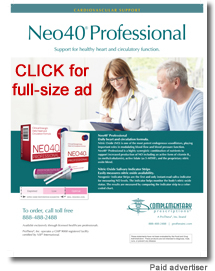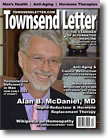|
Page 1, 2, 3
There is a natural and rather ego-gratifying tendency among most of us doctors to believe that "real" medicine began with our practice of it. Of course, the problem with this is that someone failed to inform historians and fix the history books, which tell a decidedly different story!
I can illustrate this by taking a page from my own life and career – which is also the topic of this article, namely adult stem cells and their clinical application to turning the tables on various chronic diseases and medical conditions.
I first learned about the use of bone marrow stem cells as a young physician extern in the Department of Hematology and Oncology at the University of Washington in 1969. At the time I thought that stem cells were something hitherto hidden from most other doctors and that my associates and I were going to launch a new age of regenerative medicine with them. There was actually some good reason to think this. The particular program that I was part of was directed by physician Edward Donnall ("Don") Thomas, whose illustrious career culminated in his being awarded the Nobel Prize in Physiology or Medicine with another physician, Joseph E. Murray, in 1990, for the development of cell and organ transplantation. It was Thomas who actually developed bone marrow transplantation as a treatment for leukemia. He and his team ultimately did over 4000 human marrow transplants.1
However, as I discovered later on, stem cells were not exactly unknown to medicine … and the new age of regenerative medicinewould dawn a little later than I originally anticipated.
 It was actually in the year 1908 that the Russian histologist Alexander Maksimov (1874–1928) proposed the use of the term stem cell at a hematologic society congress held in Berlin, Germany.2 He crafted this term to help describe something that he had observed about blood; namely, that all blood cells develop from a common precursor cell. This theory of common descent, or the "unitarian theory of hematopoiesis," was based on years of extensive research by Maksimov. Other experimental work that he did supported his contention that lymphocytes of the blood and lymph nodes are undifferentiated cells.3 It was actually in the year 1908 that the Russian histologist Alexander Maksimov (1874–1928) proposed the use of the term stem cell at a hematologic society congress held in Berlin, Germany.2 He crafted this term to help describe something that he had observed about blood; namely, that all blood cells develop from a common precursor cell. This theory of common descent, or the "unitarian theory of hematopoiesis," was based on years of extensive research by Maksimov. Other experimental work that he did supported his contention that lymphocytes of the blood and lymph nodes are undifferentiated cells.3
But, like many developments in medicine, there was a great lag time between the discovery of stem cells and sufficient acceptance to spur on additional exploration of their nature and possible medical uses. All told, things didn't get really going until the 1950s into the 1960s. At that time almost 200 allogenic (unrelated donor) marrow transplants had been performed in humans but with no long-term successes. Then, in 1958, Edward Donnall Thomas made history when he injected bone–marrow containing stem cells into a 3-year-old leukemia patient, which had been harvested from her identical (healthy) twin. The young child did well for 6 months, but then had a recurrence of her cancer.4
During February 1961, Canadians James E. Till, a biophysicist, and Ernest A. McCulloch, a hematologist, published findings in the journal Radiation Research which proved that the existence of cells that can self-renew repeatedly, also known as "stem cells." Both worked for the Ontario Cancer Institute (OCI) at the time.5
In 1968, University of Minnesota doctors performed the first ever hematopoietic stem cell transplantation (HSCT) for patients with inherited cellular immunodeficiency conditions: one was a child with severe combined immune deficiency (SCID) and the other a child with Wiskott-Aldrich syndrome (WAS). The donors in both cases were matched siblings.6
Then, in 1969, after years of work on histocompatibility and the development of antibiotics that inhibit transplant rejection, Thomas performed the first successful allogenic bone marrow transplants.7,8
Bone marrow transplantation, of course, proved a powerful way to turn the tables on leukemia, and was also eventually employed to successfully combat a multitude of other diseases including aplastic anemia, Hurler's syndrome and other inherited metabolic disorders, severe combined immunodeficiency (SCID), sickle cell disease, and Wiskott-Aldrich syndrome.9
Discoveries in stem cell science happened at a fairly rapid clip beginning in the 1970s. I will quickly touch on some of the highlights plus my work with umbilical cord stem cells abroad before focusing attention back on the biological and clinical treasure trove which is bone marrow.
- In 1978 stem cells were discovered in human umbilical cord blood.
- In 1981 the very first in vitro stem cell line was developed from mice.
- In 1988 embryonic stem cell lines were derived from a hamster, and in 1995 the very first embryonic stem cell line was created from a primate.
- In 1997, a lamb was cloned from stem cells and dubbed "Dolly."
- In 1997 the origins of leukemia were traced to defects in hematopoietic stem cells or cancer stem cells.
- In 1998, James A. Thompson at the University of Wisconsin isolated cells from the inner cell mass of early human embryos and developed the first embryonic stem cell lines. During the same year, John D. Gearhart at Johns Hopkins University, derived germ cells from cells in fetal gonad tissue.
- And in 2006, researchers successfully "reprogrammed," or transformed, somatic cells into a stem-cell-like state. This new type of stem cell was subsequently called induced pluripotent stem cells (iPSCs).
Sources: Murnaghan I. History of stem cell research [online article]. Explore Stem Cells. http://www.explorestemcells.co.uk/historystemcellresearch.html; History of stem cell research [online article]. EBSCO Host Connection. http://connection.ebscohost.com/health/stem-cell-research/history-stem-cell-research.
By the late 1990s I, like many physicians, had become keenly aware of the work being done with embryonic stem cells and their purported promise to usher in a new age of regenerative medicine. However, as ethical objections over using embryonic stem cells gained traction and studies appeared showing that these stem cells produce teratomas in lab animals, many researchers and doctors began focusing on adult stem cells.
In order to appreciate the appeal of adult stem cells to doctors like me who were looking for ways to remediate or cure a wide swath of diseases and medical conditions, it helps to understand the type and nature of stem cells that reside in embryos versus those typically found in nonembryonic, somatic tissues:
Embryonic stem cells are pluripotent; that is, they possess the potential to differentiate into any of the three germ layers that give rise to all the organs and such in all of us: endoderm, mesoderm, or ectoderm. This means that they can become any fetal or adult cell type. In their native embryonic environment, they get a carefully orchestrated series of signals from surrounding tissue that guides them to follow specific developmental pathways in precise ways (i.e., a baby results). When these signals are missing, out of their normal order, conflicted, or present in the wrong quantities as happens when these embryonic stem cells are implanted in the tissues or organs in animals, they can remain undifferentiated, differentiate into a cell type at odds with the tissue they are engrafted in, or even form a teratoma.
Adult stem cells, which arise after early stage or embryonic development and are found in our organs, plus adipose, dental pulp, and many other tissues, are more restricted in terms of the bodily cell types that they can become. This makes sense, as most of these stem cells never leave the tissue or organ that they are part of and basically serve to replenish cells that die off as well as promote the repair and regeneration of local tissues that incur damage due to aging, disease, or injury. In addition, stem cells exist in umbilical cord blood and the gelatinous Wharton's jelly that surrounds umbilical cord blood vessels, as well as the amnion and amniotic fluid, and placenta. These stem cells are more biologically plastic or versatile than adult stem cells taken from fully developed tissues and organs yet, unlike embryonic stem cells, do not form teratomas.
The adult stem cells in most of the body's organs and tissues tend to be a mix of multipotent, oligopotent, and unipotent stem cells. These terms refer to the developmental plasticity or versatility of these stem cells. In a word: multipotent stem cells can differentiate into a number of somatic cell types, but only into those of a closely related family of cells. Oligopotent stem cells, on the other hand, can differentiate into only a few cell types such as lymphoid or myeloid cells, while unipotent cells can generate only one somatic cell type, their own, though they possess the property of self-renewal (which sets them apart from non-stem cells).
General Classification of Stem Cell Plasticity (Developmental Versatility)
Totipotent
All bodily cell types (e.g., somatic cell types, germ cells, etc.)
Fertilized egg, zygote, morula cells
Adult totipotent stem cells
Pluripotent
All somatic cell types; e.g., heart cells, kidney cells, neurons, etc.
Inner cell mass (ICM) of blastocysts
Embryonic stem cells
Adult pluripotent stem cells; e.g., from body tissues such as bone marrow, umbilical cord, umbilical cord blood, etc.
Lineage-committed
Germ layer lineage stem cells
Ectoderm-associated stem cells
Mesoderm-associated stem cells
Endoderm-associated stem cells
Multipotent: Cell specific
Neural stem cells
Cord blood stem cells
Hematopoietic stem cells
Most bone marrow stem cells
Unipotent:
Committed to becoming a single cell type
Dopamine-expressing neurons
Muscle cells
Cartilage
Insulin-producing cells
Interestingly, bone marrow tissue and umbilical cord blood contain a wealth of multipotent stem cells, including mesenchymal stem cells, but also some pluripotent stem cells such as a small number of very small embryonic-like stem cells (VSELs). So why don't these pluripotent stem cells form teratomas when implanted or infused in animals or people? Apparently, they have been exposed to growth factors or other bioactive molecules in the more developmentally advanced tissues which they come from that are absent in embryos, and which leave them far less prone to form teratomas.
Like many doctors in countries outside the US, I learned of the pioneering work of Paul Niehans et al. and their transplantation of live fetal tissue transplantations (usually sheep) and was impressed by their reported clinical successes and safety of this treatment approach. These safe and apparently effective treatments preceded and paved the way for clinical work in people using human (nonembryonic) stem cells. Between 1991 and 2001, I worked with a Mexican orthopedic surgeon who used shark embryonic tissues to successfully treat spinal cord injuries.
Page 1, 2, 3
|
![]()
![]()
![]()





